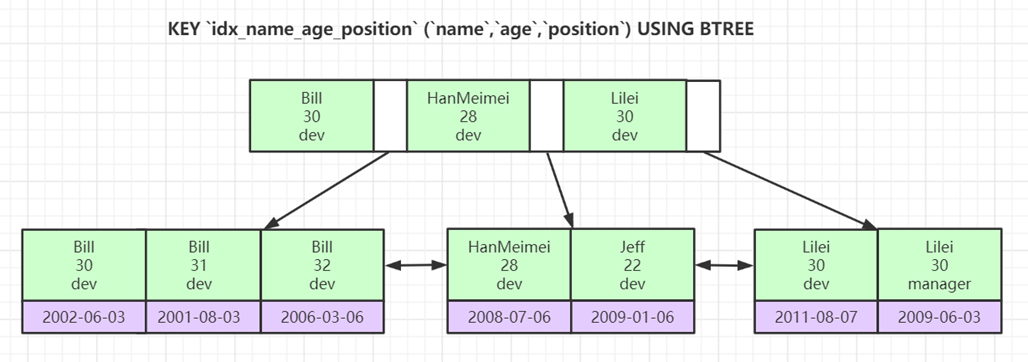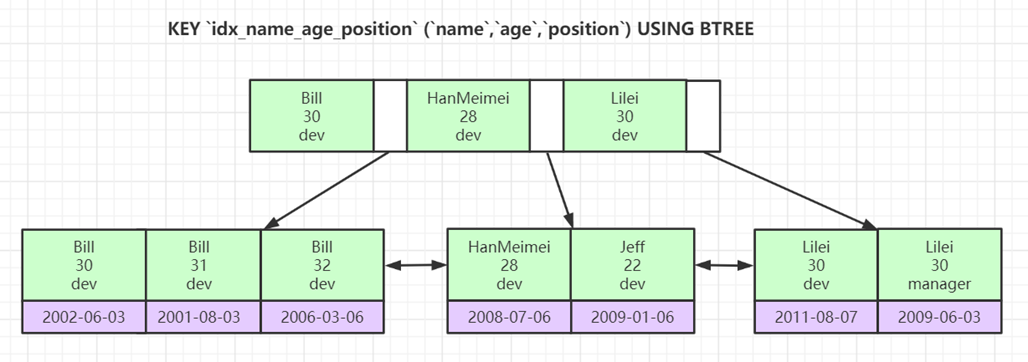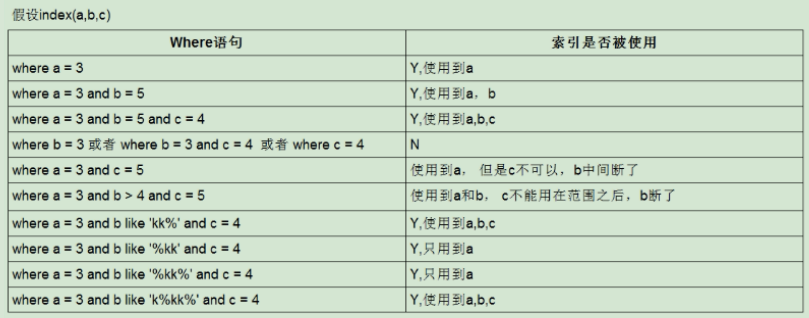Table Demo
DB Version
Case
全值匹配
最左前缀
禁止索引列上做任何操作(计算、函数、(自动or手动)类型转换)
存储引擎不能使用索引中范围条件右边的列
尽量使用覆盖索引(只访问索引的查询(索引列包含查询列)),减少 select * 语句
mysql在使用不等于(!=或者<>)的时候无法使用索引会导致全表扫描
is null,is not null 一般情况下也无法使用索引
like以通配符开头(’$abc…’)mysql索引失效会变成全表扫描操作
like 的优化
字符串不加单引号索引失效
少用or或in
范围查询优化
索引总结
搞定MySQL
Table Demo 1 2 3 4 5 6 7 8 9 10 11 12 13 CREATE TABLE employees ( id int (11 ) NOT NULL AUTO_INCREMENT, name varchar (24 ) NOT NULL DEFAULT '' COMMENT '姓名' , age int (11 ) NOT NULL DEFAULT '0' COMMENT '年龄' , position varchar (20 ) NOT NULL DEFAULT '' COMMENT '职位' , hire_time timestamp NOT NULL DEFAULT CURRENT_TIMESTAMP COMMENT '入职时间' , PRIMARY KEY (id), KEY idx_name_age_position (name,age,position) USING BTREE ) ENGINE= InnoDB AUTO_INCREMENT= 4 DEFAULT CHARSET= utf8 COMMENT= '员工记录表' ; INSERT INTO employees(name,age,position,hire_time) VALUES ('LiLei' ,22 ,'manager' ,NOW());INSERT INTO employees(name,age,position,hire_time) VALUES ('HanMeimei' , 23 ,'dev' ,NOW());INSERT INTO employees(name,age,position,hire_time) VALUES ('Lucy' ,23 ,'dev' ,NOW());
DB Version 1 2 3 4 5 6 7 8 9 mysql> select version(); + | version() | + | 5.7 .29 - log | + 1 row in set (0.00 sec)mysql>
Case 1 KEY idx_name_age_position (name,age,position) USING BTREE
联合索引
全值匹配 1 2 3 4 5 6 7 8 9 mysql> explain select * from employees where name = 'LiLei' ; + | id | select_type | table | partitions | type | possible_keys | key | key_len | ref | rows | filtered | Extra | + | 1 | SIMPLE | employees | NULL | ref | idx_name_age_position | idx_name_age_position | 74 | const | 1 | 100.00 | NULL | + 1 row in set , 1 warning (0.00 sec)mysql>
算算这个ke_len
key_len : 显示了mysql在索引里使用的字节数,通过这个值可以算出具体使用了索引中的哪些列。
【字符串】
【数值类型】
tinyint:1字节
smallint:2字节
int:4字节
bigint:8字节
【时间类型】
date:3字节
timestamp:4字节
datetime:8字节
如果字段允许为 NULL,需要1字节记录是否为 NULL
索引最大长度是768字节,当字符串过长时,mysql会做一个类似左前缀索引的处理,将前半部分的字符提取出来做索引
name varchar(24) —> 3 * 24 + 2 = 74 , 用了联合索引中的name .
1 2 3 4 5 6 7 mysql> explain select * from employees where name = 'LiLei' and age= 22 ; + | id | select_type | table | partitions | type | possible_keys | key | key_len | ref | rows | filtered | Extra | + | 1 | SIMPLE | employees | NULL | ref | idx_name_age_position | idx_name_age_position | 78 | const,const | 1 | 100.00 | NULL | + 1 row in set , 1 warning (0.00 sec)
key_len 变成了 78 ?
第二个是int , int 占 4个字节 , 74 + 4 = 78 ,这个SQL用了联合索引中的 name + age
1 2 3 4 5 6 7 8 9 mysql> explain select * from employees where name = 'LiLei' and age= 22 and position = 'manager' ; + | id | select_type | table | partitions | type | possible_keys | key | key_len | ref | rows | filtered | Extra | + | 1 | SIMPLE | employees | NULL | ref | idx_name_age_position | idx_name_age_position | 140 | const,const,const | 1 | 100.00 | NULL | + 1 row in set , 1 warning (0.00 sec)mysql>
key_len = 74 + 4 + 72 = 140
那我们跳过age 呢 ?
1 2 3 4 5 6 7 8 9 mysql> explain select * from employees where name = 'LiLei' and position = 'manager' ; + | id | select_type | table | partitions | type | possible_keys | key | key_len | ref | rows | filtered | Extra | + | 1 | SIMPLE | employees | NULL | ref | idx_name_age_position | idx_name_age_position | 74 | const | 1 | 33.33 | Using index condition | + 1 row in set , 1 warning (0.00 sec)mysql>
用了联合所以中的 name
最左前缀 如果索引了多列,要遵守最左前缀法则 , 指的是查询从索引的最左前列开始并且不跳过索引中的列。
1 2 3 4 5 6 7 8 9 mysql> explain select * from employees where name = 'LiLei' and age= 22 ; + | id | select_type | table | partitions | type | possible_keys | key | key_len | ref | rows | filtered | Extra | + | 1 | SIMPLE | employees | NULL | ref | idx_name_age_position | idx_name_age_position | 78 | const,const | 1 | 100.00 | NULL | + 1 row in set , 1 warning (0.00 sec)mysql>
符合最左前缀。
不符合最左前缀
user where : 使用 where 语句来处理结果,并且查询的列未被索引覆盖
不符合最左前缀
user where : 使用 where 语句来处理结果,并且查询的列未被索引覆盖
禁止索引列上做任何操作(计算、函数、(自动or手动)类型转换) 会导致索引失效而转向全表扫描
1 2 3 4 5 6 7 8 9 mysql> explain select * from employees where name = 'LiLei' ; + | id | select_type | table | partitions | type | possible_keys | key | key_len | ref | rows | filtered | Extra | + | 1 | SIMPLE | employees | NULL | ref | idx_name_age_position | idx_name_age_position | 74 | const | 1 | 100.00 | NULL | + 1 row in set , 1 warning (0.00 sec)mysql>
1 2 3 4 5 6 7 8 9 mysql> explain select * from employees where left (name,2 ) = 'LiLei' ; + | id | select_type | table | partitions | type | possible_keys | key | key_len | ref | rows | filtered | Extra | + | 1 | SIMPLE | employees | NULL | ALL | NULL | NULL | NULL | NULL | 3 | 100.00 | Using where | + 1 row in set , 1 warning (0.00 sec)mysql>
结合索引那个B+Tree , 特征 排好序
left 函数,MYSQL并没有做优化 ,left(name,2) 在那棵B+Tree上并没有,肯定不会走索引。
看看函数的操作
加个索引
1 alter table employees add index idx_hire_time(hire_time) using btree;
查看目前的索引
1 2 3 4 5 6 7 8 9 10 11 12 13 mysql> show index from employees ; + | Table | Non_unique | Key_name | Seq_in_index | Column_name | Collation | Cardinality | Sub_part | Packed | Null | Index_type | Comment | Index_comment | + | employees | 0 | PRIMARY | 1 | id | A | 2 | NULL | NULL | | BTREE | | | | employees | 1 | idx_name_age_position | 1 | name | A | 2 | NULL | NULL | | BTREE | | | | employees | 1 | idx_name_age_position | 2 | age | A | 2 | NULL | NULL | | BTREE | | | | employees | 1 | idx_name_age_position | 3 | position | A | 2 | NULL | NULL | | BTREE | | | | employees | 1 | idx_hire_time | 1 | hire_time | A | 1 | NULL | NULL | | BTREE | | | + 5 rows in set (0.00 sec)mysql>
在索引列上使用函数
1 2 3 4 5 6 7 8 9 mysql> explain select * from employees where date (hire_time)= '2018-09-30' ; + | id | select_type | table | partitions | type | possible_keys | key | key_len | ref | rows | filtered | Extra | + | 1 | SIMPLE | employees | NULL | ALL | NULL | NULL | NULL | NULL | 3 | 100.00 | Using where | + 1 row in set , 1 warning (0.00 sec)mysql>
变幻一下
1 2 3 4 5 6 7 8 9 mysql> explain select * from employees where hire_time>= '2018-09-30 00:00:00' and hire_time<= '2018-09-30 23:59:59' ; + | id | select_type | table | partitions | type | possible_keys | key | key_len | ref | rows | filtered | Extra | + | 1 | SIMPLE | employees | NULL | range | idx_hire_time | idx_hire_time | 4 | NULL | 1 | 100.00 | Using index condition | + 1 row in set , 1 warning (0.00 sec)mysql>
好了,实验完毕
移除索引
1 alter table employees drop index idx_hire_time;
存储引擎不能使用索引中范围条件右边的列 比对一下
1 2 3 4 5 6 7 8 9 mysql> explain select * from employees where name = 'LiLei' and age= 22 and position = 'manager' ; + | id | select_type | table | partitions | type | possible_keys | key | key_len | ref | rows | filtered | Extra | + | 1 | SIMPLE | employees | NULL | ref | idx_name_age_position | idx_name_age_position | 140 | const,const,const | 1 | 100.00 | NULL | + 1 row in set , 1 warning (0.00 sec)mysql>
key_len = 140 (74 + 4 + 78) 全部走了 idx_name_age_position (name,age,position)
1 2 3 4 5 6 7 8 9 mysql> explain select * from employees where name = 'LiLei' and age> 22 and position = 'manager' ; + | id | select_type | table | partitions | type | possible_keys | key | key_len | ref | rows | filtered | Extra | + | 1 | SIMPLE | employees | NULL | range | idx_name_age_position | idx_name_age_position | 78 | NULL | 1 | 33.33 | Using index condition | + 1 row in set , 1 warning (0.00 sec)mysql>
key_len = 78 (74 + 4 ) 走了 idx_name_age_position (name,age,position) 中的 name 和 age
为什么呢?
脑海中找到那个B+Tree
name 是相同的, 所以第二列 age 肯定是有序的, 而age这里取的是大于, age是大于, 第三列没办法保证有序。 如果age是等于,那可以,第三列有序。 上面这个图不是很合适,不要被误导了,放上去仅仅是为了让读者对B+树有个轮廓。
尽量使用覆盖索引(只访问索引的查询(索引列包含查询列)),减少 select * 语句 1 2 3 4 5 6 7 8 9 10 11 12 13 14 15 16 17 mysql> explain select * from employees where name = 'LiLei' and age= 22 and position = 'manager' ; + | id | select_type | table | partitions | type | possible_keys | key | key_len | ref | rows | filtered | Extra | + | 1 | SIMPLE | employees | NULL | ref | idx_name_age_position | idx_name_age_position | 140 | const,const,const | 1 | 100.00 | NULL | + 1 row in set , 1 warning (0.00 sec)mysql> explain select name , age from employees where name = 'LiLei' and age= 22 and position = 'manager' ; + | id | select_type | table | partitions | type | possible_keys | key | key_len | ref | rows | filtered | Extra | + | 1 | SIMPLE | employees | NULL | ref | idx_name_age_position | idx_name_age_position | 140 | const,const,const | 1 | 100.00 | Using index | + 1 row in set , 1 warning (0.00 sec)mysql>
看到第二个的 Extra : Using Index 使用了覆盖索引
mysql在使用不等于(!=或者 <>)的时候无法使用索引会导致全表扫描1 2 3 4 5 6 7 8 mysql> mysql> explain select * from employees where name != 'LiLei' ; + | id | select_type | table | partitions | type | possible_keys | key | key_len | ref | rows | filtered | Extra | + | 1 | SIMPLE | employees | NULL | ALL | idx_name_age_position | NULL | NULL | NULL | 3 | 66.67 | Using where | + 1 row in set , 1 warning (0.00 sec)
is null,is not null 一般情况下也无法使用索引 1 2 3 4 5 6 7 8 9 mysql> explain select * from employees where name is null ; + | id | select_type | table | partitions | type | possible_keys | key | key_len | ref | rows | filtered | Extra | + | 1 | SIMPLE | NULL | NULL | NULL | NULL | NULL | NULL | NULL | NULL | NULL | Impossible WHERE | + 1 row in set , 1 warning (0.00 sec)mysql>
null 值在树中会放到一起和其他节点搞个双向指针
like以通配符开头(’ $abc…’)mysql索引失效会变成全表扫描操作1 2 3 4 5 6 7 mysql> explain select * from employees where name like '%Lei' ; + | id | select_type | table | partitions | type | possible_keys | key | key_len | ref | rows | filtered | Extra | + | 1 | SIMPLE | employees | NULL | ALL | NULL | NULL | NULL | NULL | 3 | 33.33 | Using where | + 1 row in set , 1 warning (0.00 sec)
%在前
还是要回想那个索引B+Tree , % 在前面 意味着前面可能还有其他的字符串, 那在树中的有序性没法保证啊
1 2 3 4 5 6 7 8 9 mysql> explain select * from employees where name like 'Lei%' ; + | id | select_type | table | partitions | type | possible_keys | key | key_len | ref | rows | filtered | Extra | + | 1 | SIMPLE | employees | NULL | range | idx_name_age_position | idx_name_age_position | 74 | NULL | 1 | 100.00 | Using index condition | + 1 row in set , 1 warning (0.00 sec)mysql>
继续回想那个索引B+Tree , % 不在前面 意味着%前面的字符串固定, 那在树中的就是有序的,当然可以走索引
key_len = 74 ,可以推导出 走了 联合索引中的name
like 的优化 【问题:解决like’%字符串%’索引不被使用的方法?】
A: 使用覆盖索引,查询字段必须是建立覆盖索引字段
1 2 3 4 5 6 7 8 9 10 11 12 13 14 15 16 17 18 19 mysql> explain select * from employees where name like '%Lei' ; + | id | select_type | table | partitions | type | possible_keys | key | key_len | ref | rows | filtered | Extra | + | 1 | SIMPLE | employees | NULL | ALL | NULL | NULL | NULL | NULL | 3 | 33.33 | Using where | + 1 row in set , 1 warning (0.00 sec)mysql> mysql> mysql> explain select name ,age position from employees where name like '%Lei' ; + | id | select_type | table | partitions | type | possible_keys | key | key_len | ref | rows | filtered | Extra | + | 1 | SIMPLE | employees | NULL | index | NULL | idx_name_age_position | 140 | NULL | 3 | 33.33 | Using where ; Using index | + 1 row in set , 1 warning (0.00 sec)mysql>
不敢说好太多, index 总比 all 好吧 。
B: 如果不能使用覆盖索引则可能需要借助搜索引擎 ,Es等
字符串不加单引号索引失效 少用or或in 用它查询时,mysql不一定使用索引,mysql内部优化器会根据检索比例、表大小等多个因素整体评 估是否使用索引,详见范围查询优化
范围查询优化 增加索引
1 alter table employees add index idx_age(age) using BTREE;
1 2 3 4 5 6 7 8 9 mysql> explain select * from employees where age>= 1 and age<= 2000 ; + | id | select_type | table | partitions | type | possible_keys | key | key_len | ref | rows | filtered | Extra | + | 1 | SIMPLE | employees | NULL | ALL | idx_age | NULL | NULL | NULL | 3 | 100.00 | Using where | + 1 row in set , 1 warning (0.00 sec)mysql>
没走索引原因:mysql内部优化器会根据检索比例、表大小等多个因素整体评估是否使用索引。比如这个例子,可能是由于单次数据量查询过大导致优化器最终选择不走索引
优化方法: 可以将大的范围拆分成多个小范围
1 2 3 4 5 6 7 8 9 10 11 12 13 14 15 16 17 mysql> explain select * from employees where age>= 1 and age<= 10 ; + | id | select_type | table | partitions | type | possible_keys | key | key_len | ref | rows | filtered | Extra | + | 1 | SIMPLE | employees | NULL | range | idx_age | idx_age | 4 | NULL | 1 | 100.00 | Using index condition | + 1 row in set , 1 warning (0.00 sec)mysql> explain select * from employees where age>= 11 and age<= 20 ; + | id | select_type | table | partitions | type | possible_keys | key | key_len | ref | rows | filtered | Extra | + | 1 | SIMPLE | employees | NULL | range | idx_age | idx_age | 4 | NULL | 1 | 100.00 | Using index condition | + 1 row in set , 1 warning (0.00 sec)mysql>
还原索引
1 alter table employees drop index idx_age ;
索引总结
**like KK%相当于=常量,%KK和%KK% 相当于范围**






 不符合最左前缀
不符合最左前缀





 不敢说好太多, index 总比 all 好吧 。
不敢说好太多, index 总比 all 好吧 。



 **like KK%相当于=常量,%KK和%KK% 相当于范围**
**like KK%相当于=常量,%KK和%KK% 相当于范围**